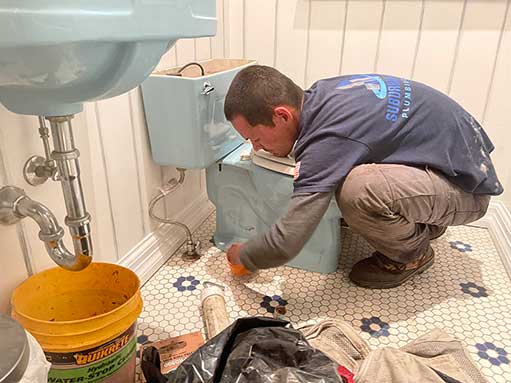
Is your toilet leaking from its base, and are you trying to figure out why? This short guide will show you how to troubleshoot and solve the issue.
Why is your toilet leaking from the base, and what can you do about it?
If you see a puddle of water on the floor near the toilet seat, your toilet is probably leaking. This problem may be accompanied by a bad odor. If the water is from your toilet, note that it could be contaminated, warns C&C Campbell Management.
Here are 6 possible reasons your toilet is leaking from its base:
Condensation
It is possible to find water on your toilet floor even when the toilet is not leaking. This happens when the temperature of the water entering the toilet tank is a lot lower than the surface temperature on the outside of the tank. This temperature difference can cause condensation on the outside of the tank.
Water that has collected on the tank surface can trickle down to form a puddle at the bottom of the toilet. If this is the cause of your problem, the surface of the toilet tank will feel wet. To stop condensation, install an exhaust fan in the toilet or run a heater to equalize the temperature inside the toilet. You can also add a condensation liner to the tank.
Leaky shut-off valve
The shut-off valve is a small control that lets you turn off the water supply to your toilet. You can usually find it on the bottom left side, behind the toilet. The shut-off valve is a common site for toilet leaks because the device is prone to leak from wear.
To check if the leak is from the shut-off valve, do this:
- Place a small bowl or cup under the shut-off valve.
- Flush the toilet and turn off the water supply to the toilet.
- Wait a few minutes and check for water inside the cup or around the area.
If there is evidence of trickling water, replace the seal or the entire valve.
A leaky pipe
To check for leaks in the pipe connections in your toilet, follow these steps. A dry environment makes it easier to spot leaks;
- Use a dry cloth to thoroughly wipe down the toilet and all nearby surfaces.
- Use your hand to feel along the pipes (pay special attention to joints).
- If you find any wet area, dry it out, wait a bit and feel it again.
Repeat this step across the length of the pipe to be sure there are no other leaks. Unlike other leaks, a leaky pipe will not stop leaking when you flush the toilet. The steps for fixing the leak depend on the location of the damage and how the pipe is installed.

After tightening the bolts, try to move the toilet seat once again. If the seat doesn’t move, replace the cap. Contact a professional plumber if it moves even after tightening the bolt.
Loose bolts
The toilet seat should be held firmly to the floor by two bolts hidden under dome-shaped caps on the toilet base. If the bolts are loose, your toilet will leak. To check if the bolts are loose, try moving the toilet seat with your hands. If it moves even slightly, the bolts are loose.
To tighten the bolts, remove the dome-shaped caps on the base of the toilet and use a pair of pliers to turn each bolt clockwise. After tightening the bolts, try to move the toilet seat once again. If the seat doesn’t move, replace the cap. Contact a local plumber if it moves even after tightening the bolt.
A worn toilet seal
A damaged toilet seal or wax ring can cause your toilet to leak from the base. This seal can be found underneath the toilet. Its job is to provide a watertight connection between the toilet and the sewer pipe. Over time, toilet seals can harden and become brittle or they can loosen. Some toilet cleaners will also cause the seal to deteriorate.
To check for leaks around the seal, dry the area thoroughly with a cloth and leave it alone for a few minutes or hours. If the area is wet when you return, it means you have to replace your toilet seal ring. This is not a complicated or expensive repair.
Leaky toilet seat
Your toilet seat may have tiny holes in it without showing any outward signs of damage. This problem is hard to detect. But if your toilet leaks every time you flush it and the issue is not due to any of the above causes, you may consider this as a probable cause. The only solution for a bad toilet seat is to replace it.
In conclusion, the above are the most common reasons your toilet would leak from its base. If you have taken the recommended steps for troubleshooting the leak and it persists, you may want a professional bathroom plumber to look at your toilet.




